The Surface 3 Review
by Brett Howse on May 4, 2015 9:00 AM ESTDisplay
When Surface Pro 3 moved to a 3:2 aspect ratio, it made a lot of sense. 16:9 in a tablet makes for a very poor experience, and in a laptop, it is not much better. Almost everyone has moved to 16:9 in the laptop space and the lack of vertical height can make for a less than ideal experience. Most web content is vertical, and working in Office means you want vertical space as well. The widescreen does help with two windows snapped open at once, but I always find myself craving more vertical room.
On a tablet, I feel that 16:9 is even worse. Holding a 16:9 device in one hand can feel very heavy due to the length of the tablet, and turning it to portrait means that it is very tall and skinny. The move to 3:2 really squares up the device, and makes it a lot more balanced in either direction. Holding it in one hand is much easier, and finally portrait mode is usable on the Surface.
So the aspect ratio is a big improvement. The display size also has a slightly wider corner to corner of 10.8 inches versus 10.6 inch model that came before this. The actual width of the display is about 9 inches, compared to 9.2 on the outgoing Surface 2 model. The display height is now 6 inches, up from 5.2, so the total area of the display is almost 54 square inches, up from 48 inches on the outgoing model.
To fill this display, we have a Panasonic panel with a resolution of 1920x1280. This is roughly the same pixel density as the Surface Pro 3’s slightly larger 12 inch 2160x1440 display, coming in at 217 pixels per inch. It is not the highest PPI of a tablet, but it makes a good compromise between desktop and tablet use. Speaking of desktop use, I found that it makes a perfectly acceptable size for a small notebook, and even with touch it was not too difficult to work with the icons.
When Microsoft launched Surface 3, it said “with incredibly accurate colors and clarity from multiple viewing angles” and that would be excellent to see. The Surface Pro 3 has a decent display, but it was not the most accurate device we’ve tested.
To do our display testing, we use SpectraCal’s CalMAN 5 suite with a custom workflow. Brightness and contrast readings are taken with an X-Rite i1Display Pro colorimeter, and color accuracy is measured with an X-Rite i1Pro spectrophotometer. We target 200 nits brightness when doing our tests.
Brightness and Contrast
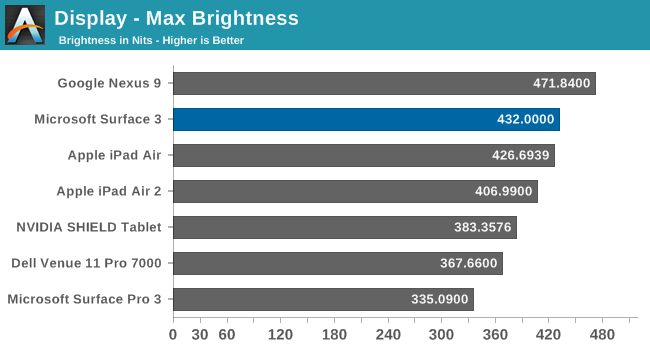
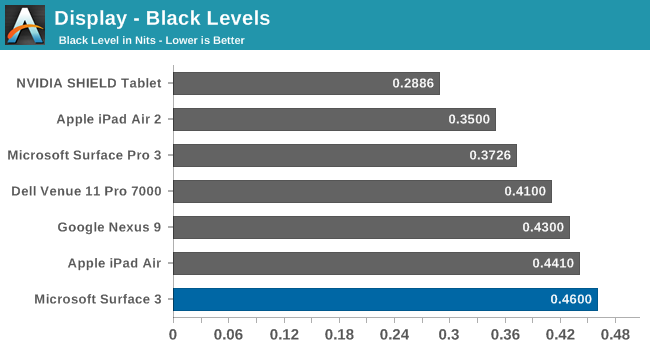
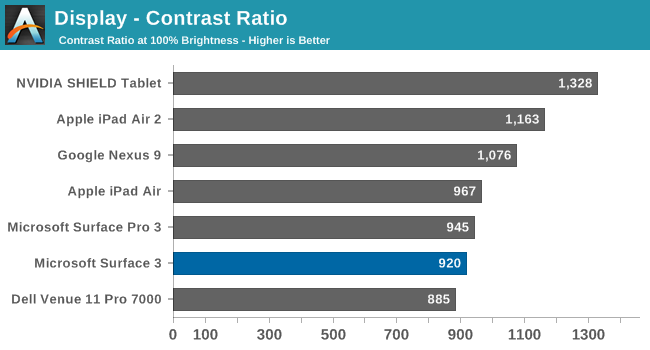
The Surface 3 gets quite bright, coming in at 432 nits at maximum output. The black levels are a bit high, but overall contrast is a decent 920:1. This makes the Surface 3 almost 100 nits higher than the Surface Pro 3 that Anand reviewed last year, which is a good start for this less expensive version.
Grayscale
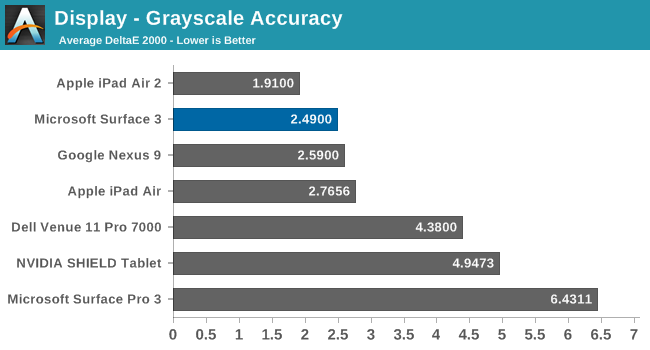
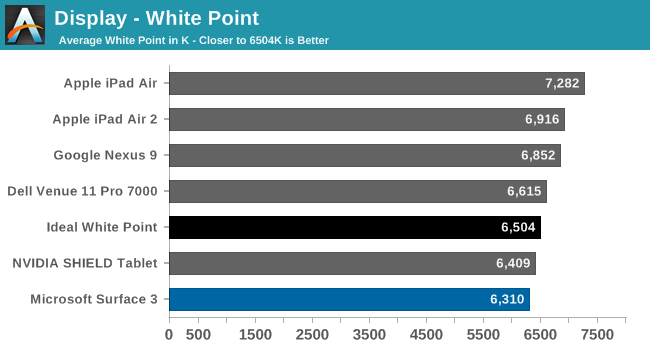
The grayscale average for the Surface 3 is very good, coming in just about at 2.5 as an average for the sweep. There is a bit of a spike at 25% but it is not indicative of the overall calibration. Gamma is a bit low, but the white point is fairly close to the ideal value.
Saturation
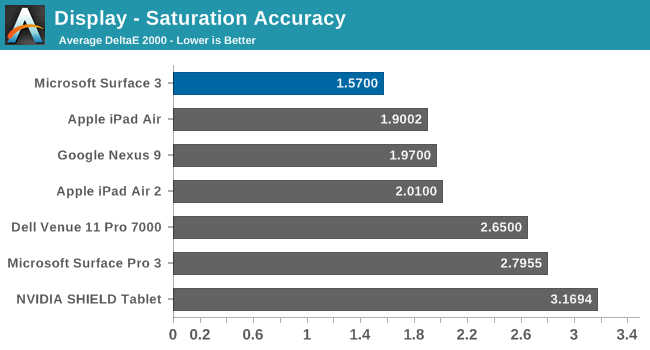
The accuracy on our saturation tests is outstanding, with an overall average score of just 1.57. Looking at the individual colors, the red is a bit oversaturated at 100%, and blue tends to be undersaturated, but the amount of error is very small.
Gamut and Gretag Macbeth
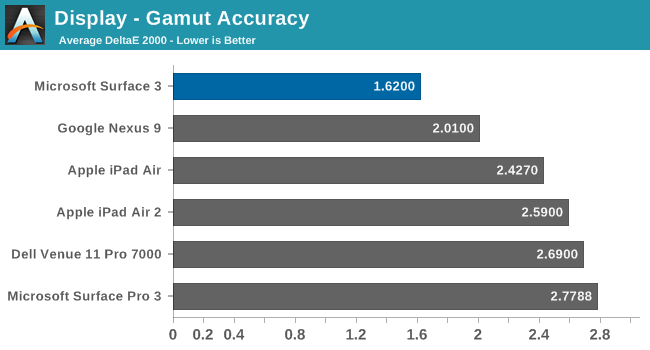
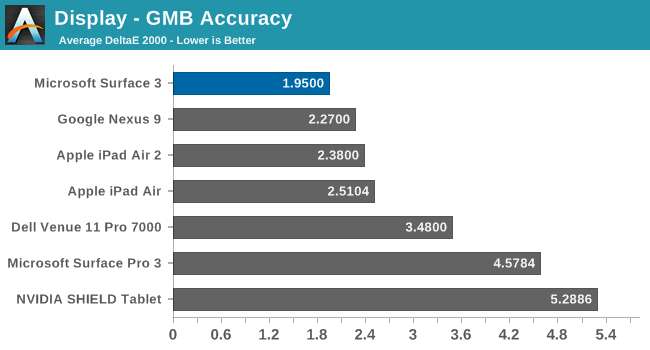
Once again the Surface 3 comes in with fantastic scores on these two tests, with the comprehensive GMB test under 2. When we are doing these tests, values under 3 are considered good, and the Surface 3 has passed with amazing scores. The best part of this is that all of this is done without the use of an ICC profile, so that means the hardware is being calibrated directly. ICC profiles can fix some issues, but not all programs respect them so having it done in hardware is a much better option.
Calibrated
Since this is a full x86 Windows operating system, we can also calibrate the display with the CalMAN software. Even though it was very good out of the box, the calibration pulls it even closer to perfection.
Surface 3 has one of the most accurate displays we have ever tested, which is great to see in what is considered the value member of the Surface family. Microsoft promised an accurate display and they have delivered.


















265 Comments
View All Comments
BlueBomberTurbo - Thursday, May 7, 2015 - link
Adobe only has mobile apps for iOS and Android. Not very useful for any serious production, and a stopgap measure at best until you get to a real computer. Surface 3 can run the real desktop software out of the box. And yes, you can use PS and LR, since I was able to use them on my Lenovo Thinkpad 8 (Atom Z3770 + 2GB/64GB), and the Surface 3 has a significant bump in GPU power.AlluringRaja - Tuesday, May 5, 2015 - link
Nice review. Thanks to AnandTech.romprak - Tuesday, May 5, 2015 - link
Great, thorough review - we are picking up ours this afternoon at our local BestBuy. Looking forward to playing around with it today. It will be replacing my wife's 2009 iMac that is on its last legs (overheats and I think the GPU might be failing, it gets really hot and Yosemite has just made things worse). She manages all her homeschooling and her own tasks on that computer. I'm going to give her my old 27" monitor for when she is docked at home (my Surface Pro 3 now runs a 34" Ultrawide Dell), but otherwise she can just use it on her lap for managing the kids' curriculum, etc.damianrobertjones - Tuesday, May 5, 2015 - link
"This saves a bit of weight, but also prevents the keys from being folded behind and making for an uncomfortable device to hang on to"Have you ever thought of turning the keyboard around? You then hold onto the flat surface with the keys pressed to the back of the S3.
Brett Howse - Tuesday, May 5, 2015 - link
Nope I've never thought of that, but I think I'd still rather just take it off when needed.BlueBlazer - Tuesday, May 5, 2015 - link
The 4GB RAM version has higher benchmark scores at http://www.notebookcheck.net/Microsoft-Surface-3-T... possibly due to dual channel memory used. Will there be a review of that 4GB RAM version?Brett Howse - Tuesday, May 12, 2015 - link
Hi sorry for the delayed response on this I wasn't able to check dual channel with CPU-Z. The 2 GB model is dual-channel with 2x1GB DIMMs.yefi - Tuesday, May 5, 2015 - link
Liking the mini-dp on this. Shame it can't support 4k according to the SoC's datasheet, but it would be pretty sweet to hook this up to a 30" monitor in any case.damianrobertjones - Wednesday, May 6, 2015 - link
I was under the impression that it DOES support 4k but only @30Hzyefi - Wednesday, May 6, 2015 - link
It says the hdmi can do 4k @30Hz, but doesn't mention anything for displayport. Would be nice if it could do it.